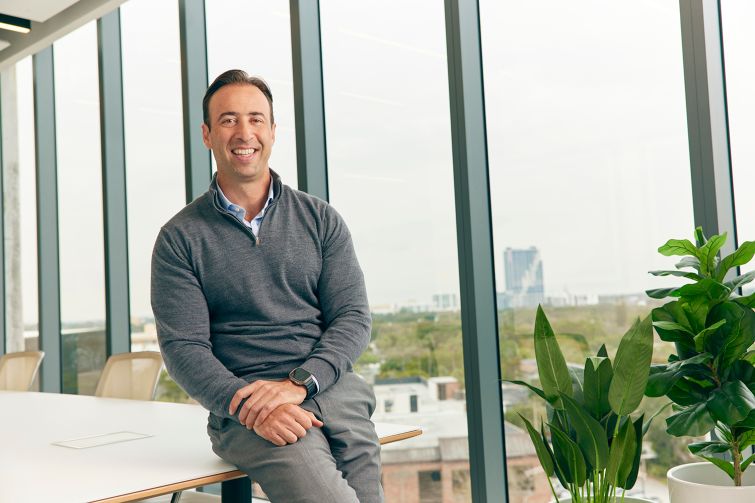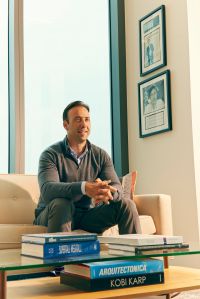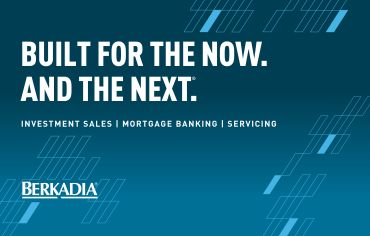13th Floor’s Arnaud Karsenti Is Betting Big on Miami
Real estate wasn’t originally in the cards for Arnaud Karsenti, but he bet big on Miami’s growth 20 years ago with his 13th Floor Investments — and won
By Cathy Cunningham January 24, 2024 6:00 am
reprints
The delicate art of dealmaking is one that several in the commercial real estate industry have mastered over the years. Some grew up in real estate families, absorbing knowledge and hunger for the craft through osmosis at dinner tables. Others came from far-flung lands with no familial connection to real estate, but with the art of the deal firmly embedded in their DNA nevertheless. Arnaud Karsenti falls in the latter camp. (More on his double helix later.)
Karsenti is the managing principal of 13th Floor Investments, a real estate investment and development firm based in Miami. The 40-person firm got its start coming out of the Global Financial Crisis, but prior to that he developed a taste for business, launching — and selling — a storage business, and dabbling in real estate ownership before jumping head first into development.
Today, 13th Floor has roughly $5 billion of assets under management spanning residential, commercial, industrial, value-add and development projects. Projects include the luxury apartments Motion at Dadeland and the Link at Douglas, a 7.5-acre mixed-use, transit-oriented development, all in Miami; Village Square in Coral Springs, Fla.; and Parks at Delray in Delray Beach, Fla.
Commercial Observer sat down with Karsenti as the CRE Finance Council’s (CREFC) January conference in Miami was drawing to a close.
This interview has been edited for length and clarity.
Commercial Observer: You just attended the CREFC conference. Any big takeaways?
Arnaud Karsenti: It’s interesting, because the conference serves as a pretty good barometer of real estate industry sentiment. I remember at the same conference a year ago, everyone was bracing themselves for a tough ’23, and there were all sorts of mantras out there, like “Survive until ’25.” This year feels different, and there’s renewed optimism with people expecting interest rates to come down.

One thing I’ve learned about the Fed is that they don’t play poker. They actually tell you what they’re going to do. In early ’22, the Fed said, “We’re going to start increasing interest rates” and, sure enough, by May the first hike took place. So, on the heels of their December meeting, everybody seems much more excited about the opportunities that lie ahead, because our activities as an industry are largely a function of the capital markets that we all swim in.
With that said, I do think the micro picture in Miami has remained strong despite the tough macro environment these past 18 months, and you’re seeing that in our home values, our rents, our occupancies and in the continued strength of demand for South Florida.
Do any good distressed investment opportunities exist in Miami today?
It’s sector-specific, but distress usually comes in the form of an asset that is either overlevered or not performing for a long period of time. We don’t think that the multi-family space and, frankly, the broader real estate market is overlevered today. We’re not seeing unhealthy levels of leverage like we did in the GFC.
What we are seeing, however, is a lot more stress because leverage is more expensive.
We’re seeing the debt service coverage ratios and debt yields be much lower. Those are factors that would lead to distress if they stuck around for a long period of time. If rates were to continue to increase for years, then you would have to see some distress because the people that bought their assets at 4 or 5 cap cannot endure the cost of borrowing at a 7 or 8 percent rate for too long, but they can sustain it for a finite, shorter period of time.
With that said, a lot of debt maturities are coming due this year, and I’m keeping a close eye on CMBS, because those lenders aren’t relationship-driven, but driven by the covenants of their loans and maturity dates. It’ll be interesting to see whether those loans will lead to distressed opportunities or not.
Do you have any CMBS loans today?
We’ve never taken on any CMBS loans. Back in the recession, we were buying pools of loans and sometimes we were involved in some CMBS transactions that way, but I’ve never been a CMBS borrower. We like to know who we’re doing business with, so we’d like to deal with banks and capital that we have a relationship with.
What were some of the biggest lessons you learned during the GFC?
One lesson I learned is when you’re dealing with assets in distressed times, you need to be really good at making decisions quickly. Those who succeed are able to capture opportunities when they see them, and not hesitate.
I used to say that you’re better off using a sledgehammer rather than a scalpel. We as an industry are so used to being micro-
analytical on all of our deals, and we at 13th Floor are used to analyzing deals extensively. But I think there comes a time when things are cheap enough or distressed enough where the analysis takes a bit of a back seat to what you’re paying for what you’re getting. At that point, you need to make a decision and typically need to strike and buy the deal, fast.
Those that are able to move quickly have a huge advantage over those that don’t. That’s one of the reasons why we’ve always been very adamant about raising committed capital. We operate our business through funds, and it gives us the ability to move immediately on the deals that we find interesting. It’s a huge advantage, because in times of distress or when times are tough, capital is very hard to find. When times are great, capital’s easy to find, but prices are high, so there’s a mismatch between availability of capital and availability of opportunity.
By having a fund on hand at all times, you have the resources. We’re not alone in this, there are thousands of private equity and real estate funds in the world. But in our market, we’re one of the few groups that has committed on-hand capital that can strike quickly when we see something interesting.
You’re currently deploying your fifth fund, which is $300 million. Where are you deploying it today?
Our core strategies remained largely unchanged. We’re deeply invested in the residential mixed-use space in Florida and the Southeast. Within that, we’re very active and continue to see opportunities in multifamily, single-family rentals and condominiums. Within those three buckets, we are seeing a lot of different scale opportunities — some of them are entry-level workforce, some of them are higher-end luxury product projects. But, overall, they’re addressing a unanimous trend, which is the high demand from the population that wants more product in Florida that’s high quality and good value.
There are a couple of alternative asset classes that we’ve also been invested in and are exploring further, including the cold-storage space, the data center space and the industrial space. They represent a small but still meaningful portion of our fund.
Do you find there’s any less competition for industrial opportunities today, given the state of the market?
It’s still very competitive. The big players are still very, very active, but we’re finding opportunities in the smaller, middle-market industrial sites or properties and are currently under contract on one. We’re not afraid to roll up our sleeves and buy some properties that may be too small for some of the bigger players. Where there’s often opportunity today in industrial is where there are under-market leases that aren’t rolling over for a number of years. Maybe the cap rates are a little lower than you’d like today, but you can make a bet that they will increase when those leases are reset at market rates.
How do you approach the management of your pipeline, given its diversity across asset classes?
We’re generalists and work on everything at the same time. The way we think about it is we just go down the food chain, or the list of our projects, and focus on those that we have the highest conviction on. We also have a pretty substantial RFP [Request for Proposals] practice where we bid on projects and our counterparty is more of a
quasi-governmental agency — even a church or a school or even a religious or government institution. It’s an interesting practice that’s grown quite a bit in our company, and we’ve done a fair amount of transit-oriented developments that relate to that practice.
One of those projects is the Link at Douglas, a mixed-use transit-oriented development at the Douglas Road Metrorail station. What was the first project within that RFP practice, and how is Link at Douglas coming along?
The first building that we delivered was 1010 Brickell, which actually happened to be exactly adjacent to the Metromover station on Brickell Avenue. That was a private deal — it just happened to be close to transit — but we learned a lot about how to build and design around a train station.
Our very first true transit-oriented development was Motion at Dadeland [a 25-story rental building adjacent to Miami-Dade Metrorail’s Dadeland North station]. Then, we bid and won the Link at Douglas, which was a county-based RFP with the Miami Dade Transit Authority. It’s been going great. We built the first half of the project, the first two buildings, and we’re excited about continuing those next several buildings, starting with this year breaking ground on the third tower.
It must be a really rewarding process to see all these different phases come to life.
Especially since it’s literally going up right behind my office window. It’s something we see every day. Development doesn’t always go smoothly, though. One of my investors used to say development is a young man’s business. As I get older, I understand why that comment was made [laughs]. It’s been amazing to see it rise, though, and it’s more than just the building itself — it’s witnessing the transformation of an area that, frankly, was an obsolete or desolate tract of land that wasn’t really activated at all. Now, to see so much occupancy and vibrancy there is great.
What’s also really awesome is the opportunity to work with the city and county, and work in liaison with them to accomplish their goals in the community, which is to increase ridership, make housing more affordable, and create workforce housing, and beautify the train station. It gives you a sense of impact that you may otherwise not get when you’re dealing with just a private deal.
Did you grow up in Miami?
I’m originally from France, but I moved here from Paris when I was 3 years old.
What prompted your family’s decision to move?
My father’s lifelong dream was to be an American. My mother was actually his second marriage. My father already had children, and my mother did not but she really wanted kids. My father really didn’t want more kids — understandably so at his age at the time, because they were 20 years apart, but he really wanted to come to the United States. So, they made a deal: My mother said that she would move to the States as long as they had children. So, I was the product of that deal, and thank goodness for me it was made [laughs].
When you were growing up, did you gravitate toward any aspects of real estate?
I didn’t even know what real estate was. My family had no links to real estate whatsoever. My parents were small business owners who worked in the import/export business and the fashion industry, and also the dry-
cleaning business, so a small-time entrepreneurial family. Other than our homes, we never touched real estate.
The fascination for real estate for me began when I was starting my first business [student storage box company Collegeboxes, which Karsenti sold to U-Haul in 2004] — which also was not real estate related. I was in Miami and reading about all this real estate action, and all these great projects. This was back in 2003, when Miami was experiencing its first big growth spurt. I had a friend of mine who got me into real estate finally by asking me to join him on one of his first acquisitions in Little Havana. We ended up doing a bunch of deals together and I got the bug. I loved it. I didn’t know much about what I was doing, but I loved that you were dealing with transactions, with properties, and with a lot of people. Also, there’s a creative aspect to real estate, which I loved then and love now.
What were the Little Havana investments?
The Little Havana properties were somewhat nondescript little houses and duplexes and shopping centers. We bought them for income and because we thought they were interesting, but what I started to realize was that developers were buying these deals to tear them down and build new projects. That’s how I learned development.
Was there a particular moment that you can remember when you thought, “OK, real estate is going to be my career”?
Yes, at the end of business school. I was pretty deliberate in my decision to either head back into an operating business, like Collegeboxes, or start more of a project- or transaction-oriented business, like the real estate business. I thought about it long and hard, and I really thought that it fit my personality better to be in the project business.
How so?
I like projects, I always have. Ever since I was a kid. I used to love science fair projects and loved building with Legos. I still love building with Legos [laughs], especially with my kids. And I enjoy things that require a setup, execution, and then ultimately a delivery of something. And that is kind of what development is.
So, after business school I decided to get into the real estate business in earnest, but this time I wanted to set up a real company. I didn’t want to do it just by buying a couple of little properties.
And that’s when 13th Floor came about?
Yes. Although, looking back I don’t know the exact launch date. We bought our first flagship deal in 2008, and that’s kind of how I think about the beginning of the business. Since then we’ve done 65 deals, and grown to a medium-size company that we’re very proud of.
Miami has become an increasingly competitive hotspot for investment these past five years. How do you view its evolution since 13th Floor started?
Miami went from being almost an extension of South America to one of the most important national cities. It was always an NFL city by virtue of having a football team, but it wasn’t in the same conversation as New York, L.A., Dallas, Chicago or Washington, D.C. Today, it absolutely is and it probably ranks at the top of that list in terms of gravitational pull, in terms of where people want to be, want to live and want to grow their businesses.
So, I think there’s been just a total transformation of the perception of Miami. I give the real estate business, frankly, a fair amount of credit for that, because the real estate business has made it interesting for people to come down and be here. We build the buildings that those folks want to move to or work in.
How do you feel about the influx of New York companies and individuals?
Any growth, as long as it is healthy and productive in a way that is growing the economy, is great. I remember in 2010, when [Miami Heat] got LeBron James, that was probably the biggest economic stimulus that the city had seen. He was just one person, but the economic impact that he had on the city was amazing.
I think you’re seeing it again, when you see the Ken Griffins of the world and the large companies coming down here. You’re seeing that same level of star power that Miami is attracting, and you not only have to embrace it, you have to be grateful. There are some unfortunate byproducts of that. The city’s gotten more expensive, but that’s the price you pay for growth.
So, is Citadel the new LeBron?
[Laughs] I think it is, I really do. I think it has global recognition. Citadel to the business community is like LeBron to the sports community. It’s one of those names that are at the top of the pyramid, and where they go says a lot. These organizations have the opportunity to choose wherever they want to be. And if they decide that they want to be in Miami, it says a lot about why — no different than when Amazon made the decision to be in D.C.What’s cooking for 13th Floor in 2024?
We’ve got a lot going on. We have three or four multifamily projects that we’re getting ready to start. We also have in our homebuilding division, with five or six active projects right now — some of them are for rent, some of them are for sale. Those are benefiting from great tailwinds because the single-family home market here remains very supply-constrained.
Then, we’ve got a small handful of really exciting for-sale condominium projects that we were going to be launching this year, on the beach and in Brickell. We’re very enthused about those projects and they’re very special, unique real estate. And, so, we’ve got a pretty full plate in addition to the fund we’ve raised, which is always looking for more opportunities and more deployment. So I think we’re in a good spot, we just have to go to work and focus and stay out of trouble [laughs].
How do you relax outside of this busy pipeline?
I have a 15-year-old boy, a 13-year-old girl and a 10-year-old boy. They’re amazing. So, anything that I do that involves my children is what I love, whether it’s playing tennis with my son or swimming with my other son, or taking my daughter for ice cream, or just kind of hanging around the house and watching a movie. I love being with them.
In terms of other fun things I like to do, I love to play tennis, work out and travel. I happen to be a not-very-good amateur pianist. I’m still trying to figure out how to do it well, but I love to learn new things.
Taking up piano at a later age is no mean feat!
Learning an instrument at an older age is very humbling [laughs]. The amount of hours you spend versus the results you have to show for it is a pretty bad ratio. But I love the challenge. It also distracts me and relaxes me, and it’s hopefully something I should now be able to do forever.
Cathy Cunningham can be reached at ccunningham@commercialobserver.com.


